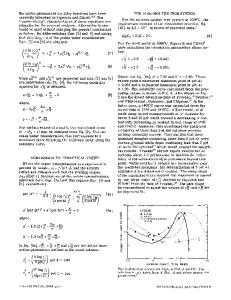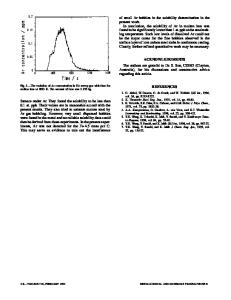Comments on the solubility of carbon in molten aluminum
- PDF / 99,176 Bytes
- 1 Pages / 590.28 x 785 pts Page_size
- 14 Downloads / 359 Views
50
D
El
40
D
El
t~
.
& .e 30'
Comments on the Solubility of Carbon in Molten Aluminum
Thi ....
950
Recently, 9 and McCune m published a paper on phase equilibria in the A1-Si-C system. They found experimentally that the solubility of carbon (by weight) in aluminum was: [1]
in the temperature range 1700 ~ to 2156 ~ If these results are extrapolated down to temperatures close to the melting point of aluminum, they correspond to a solubility of carbon in aluminum: 1.3 9 10 -2 ~pm (by weight) at 660 ~ (the melting point), 3.6 9 10- ppm at 700 ~ and 8.8 ppm at 982 ~ This is rather different from the values given by Dorward, TM which were 10 p p m at 700 ~ and 300 ppm at 982 ~ We have tried to resolve this discrepancy by analyzing melts saturated in carbon and held at 1000 ~ This report concerns carbides in samples taken from the electrolysis cells. Such melts are s~iturated in carbon and also contain traces of carbides (A14C3). When a sample is taken of the melt, carbon will react continuously with the melt during cooling, and carbides are formed. Therefore if the cooling is slow, nearly all the carbon is converted to carbides. Thus, if 9 and McCune's results can be extrapolated, the samples will contain around 0.004 wt pct carbides, whereas the carbide concentration will be 0.12 wt pct if Dorward's results are correct. (It is assumed that A14C3 is stoichiometric.) The molten metal to be analyzed was taken from electrolysis cells held between 960 ~ and 1000 ~ The standard deviation in temperature was 2 ~ Samples of the melts were taken with a disc-shaped crucible. 0.5 g samples were made and subsequently dissolved in a sodium hydroxide solution. The carbides then react selectively with water, and methane is formed. The carbide concentration in the metal sample was determined by measuring the amount of evolved methane, as described in a previous paper.I2] The analysis of carbides in samples taken from 10 cells is
CHRISTIAN J. SIMENSEN, Principal Scientist at SI, Oslo, Norway, is Visiting Scientist, Comalco Research Centre, P.O. Box 316, Thomastown, Victoria 3074, Australia. Manuscript submitted May 18, 1988.
k
| Cune
20
METALLURGICAL TRANSACTIONS A
~
o
CHRISTIAN J. SIMENSEN
Cc = 1511 9 e x p ( - 2 3 , 7 9 7 / T )
[]
a~
I
,
,
,
,
,
,
960
970
980
990
1000
1010
~"
T('C) Fig. 1--Carbide concentration as a function of temperature of the molten metal.
shown in Figure 1. The carbide concentration decreases from 50 p p m to 24 p p m when the t e m p e r a t u r e of the molten aluminum decreases from 1000 ~ to 960 ~ This correlation between temperature and carbide content is a strong indication that the major fraction of the carbide atoms was in solution in the molten metal. As shown in Figure 1, the carbide concentration extrapolated from 9 and McCune's results is in good agreement with our results. The estimated carbide concentration based on Dorward's results is decades higher. The conclusion is that the solubility of carbon given by Eq. [1] can be extended down to at least 960 ~ The re
Data Loading...











